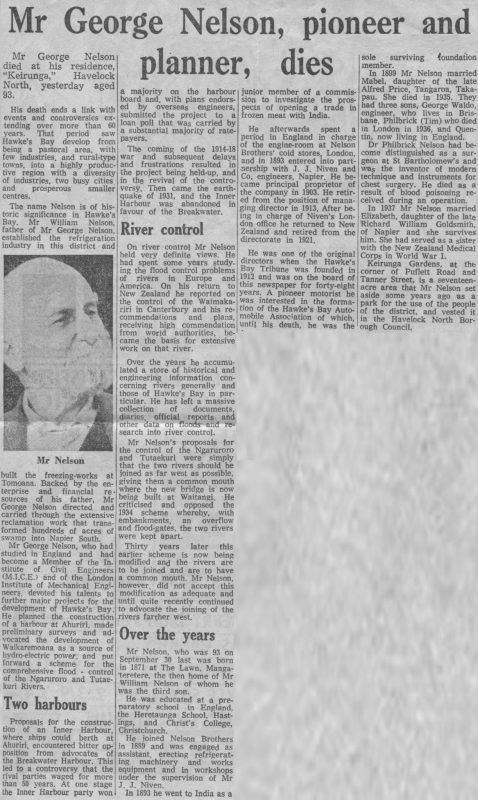Mr George Nelson, pioneer and planner, dies
Mr George Nelson died at his residence, “Keirunga,” Havelock North, yesterday aged 93.
His death ends a link with events and controversies extending over more than 60 years. That period saw Hawke’s Bay develop from being a pastoral area, with few industries, and rural-type towns, into a highly productive region with a diversity of industries, two busy cities, and prosperous smaller centres.
The name Nelson is of historic significance in Hawke’s Bay. Mr William Nelson, father of Mr George Nelson, established the refrigeration industry in this district and Mr Nelson built the freezing-works at Tomoana. Backed by the enterprise and financial resources of his father, Mr George Nelson directed and carried through the extensive reclamation work that transformed hundreds of acres of swamp into Napier South.
Mr George Nelson, who had studied in England and had become a Member of the Institute of Civil Engineers (M.I.C.E.) and of the London Institute of Mechanical Engineers devoted his talents to further major projects for the development of Hawke’s Bay. He planned the construction of a harbour at Ahuriri, made preliminary surveys and advocated the development of Waikaremoana as a source of hydroelectric power, and put forward a scheme for the comprehensive flood – control of the Ngaruroro and Tutaekuri Rivers.
Two harbours
Proposals for the construction of an Inner Harbour, where ships could berth at Ahuriri, encountered bitter opposition from advocates of the Breakwater Harbour. This led to a controversy that the rival parties waged for more than 50 years. At one stage the Inner Harbour party won a majority on the harbour board and, with plans endorsed by overseas engineers, submitted the project to a loan poll that was carried by a substantial majority of ratepayers.
The coming of the 1914-18 war and subsequent delays and frustrations resulted in the project being held-up, and in the revival of the controversy. Then came the earthquake of 1931, and the Inner Harbour was abandoned in favour of the Breakwater.
River control
On river control Mr Nelson held very definite views. He had spent some years studying the flood control problems of rivers in Europe and America. On his return to New Zealand he reported on the control of the Waimakariri in Canterbury and his recommendations and plans, receiving high commendation from world authorities, became the basis for extensive work on that river.
Over the years he accumulated a store of historical and engineering information concerning rivers generally and those of Hawke’s Bay in particular. He has left a massive collection of documents, diaries, official reports and other data on floods and research into river control.
Mr Nelson’s proposals for the control of the Ngaruroro and Tutaekuri were simply that the two rivers should be joined as far west as possible, giving them a common mouth where the new bridge is now being built at Waitangi. He criticised and opposed the 1934 scheme whereby, with embankments, an overflow and flood-gates, the two rivers were kept apart.
Thirty years later this earlier scheme is now being modified and the rivers are to be joined and are to have a common mouth. Mr Nelson, however, did not accept this modification as adequate and until quite recently continued to advocate the joining of the rivers farther west.
Over the years
Mr Nelson, who was 93 on September 30 last was born in 1871 at The Lawn, Mangateretere, the then home of Mr William Nelson of whom he was the third son.
He was educated at a preparatory school in England, the Heretaunga School, Hastings, and Christ’s College, Christchurch.
He joined Nelson Brothers in 1889 and was engaged as assistant, erecting refrigerating machinery and works equipment and in workshops under the supervision of Mr J. J. Niven.
In 1893 he went to India as a junior member of a commission to investigate the prospects of opening a trade in frozen meat with India.
He afterwards spent a period in England in charge of the engine-room at Nelson Brothers’cold stores, London, and in 1893 entered into partnership with J. J. Niven and Co, engineers, Napier. He became principal proprietor of the company in 1903. He retired from the position of managing director in 1913, After being in charge of Niven’s London office he returned to New Zealand and retired from the directorate in 1921.
He was one of the original directors when the Hawke’s Bay Tribune was founded in 1912 and was on the board of this newspaper for forty-eight years. A pioneer motorist he was interested in the formation of the Hawke’s Bay Automobile Association of which, until his death, he was the sole surviving foundation member.
In 1899 Mr Nelson married Mabel, daughter of the late Alfred Price, Tangaroa, Takapau. She died in 1935. They had three sons, George Waldo, engineer, who lives in Brisbane, Philbrick (Tim) who died in London in 1936, and Quentin, now living in England.
Dr Philbrick Nelson had become distinguished as a surgeon at St Bartholomew’s and was the inventor of modern technique and instruments for chest surgery. He died as a result of blood poisoning received during an operation.
In 1937 Mr Nelson married Elizabeth, daughter of the late Richard William Goldsmith, of Napier and she survives him. She had served as a sister with the New Zealand Medical Corps in World War I.
Keirunga Gardens, at the corner of Puflett Road and Tanner Street, is a seventeen-acre area that Mr Nelson set aside some years ago as a park for the use of the people of the district, and vested it in the Havelock North Borough Council.












Do you know something about this record?
Please note we cannot verify the accuracy of any information posted by the community.